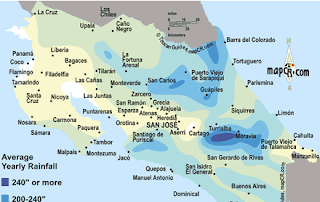*PDF version is available at library link
Instruction
Manual for Operating and Maintaining
the Micro-Hydroelectric System in Barú, Costa Rica
the Micro-Hydroelectric System in Barú, Costa Rica
Harvey Mudd College
Costa Rica Project
Team
________________________________________________________________________________________
Introduction
This
document presents instruction for operating and maintaining the
micro-hydroelectric system in Barú, Costa Rica. The system is designed for operating during wet
season, generally from June to December. For dry season, the system is
recommended to be turned off.
Wet Season Operation
1.
Check electrical connection of generator and inverter. They should be plugged to
appropriate spot. The inverter takes few minutes to warm up (Figure 1).

Figure 1. Inverter and DC and
AC circuit breaker
2.
Open the two red valves on the micro-hydro station (Figure 2). The valves
should be open fully to generate the maximum electricity.

Figure 2. Two red valves on micro-hydro station
3. Check
the filter on the dam site (Figure 3). The filter should be attached before
running the system.

Figure 3. Debris filter
4. Open
half of the red valve on the dam site (Figure 4), and let water flow into the
pipe path for 5 minutes. This prevents PVC pipe shrinkage due to sudden
pressure change in the pipe path.

Figure 4. One red valve on the
dam site
5. After
5 minutes, open the valve fully.
6. Check
water coming out from the end of pipe path. If the water does not come out,
repeat step 2~5 carefully, and check any cracks on pipe path.
7. Check
the turbine spinning, and see how much electricity is generated on the inverter
LED screen (Figure 5)

Figure 5. Inverter with LED
screen on
Turning Off Operation (For Dry
Season)
1.
Close half of the red valve on the dam site (Figure 6). Be careful with sudden
pressure change in the pipe path.

Figure 6. One red valve on the
dam site
2.
Leave the half closed valve for 5 minutes.
3.
Close the valve fully.
4.
Check the water does not come out from both valves on the micro-hydro station
5.
Close both valves on the micro-hydro station (Figure7).

Figure 7. Two red valves on micro-hydro station
6.
Shut off DC and AC circuit breaker (Figure 8).

Figure 8. Inverter and DC and
AC circuit breaker
Maintenance
1. Follow
turning off operation above, if there is a crack on the pipe path (Figure 9). Then,
contact Harvey Mudd College Costa Rica Project team, and report the problem.

Figure 9. Example of pipe
crack
2.
Check the filter frequently, and clear leaves and other organic material that
can easily block the water flow. Also, the poor filter makes pipe rock jam into
the (Figure 10).

Figure 10. Example of rock jam
into the pipe
3. Clear
the wire path, and prevent the wire from submerging in the water, especially
during wet season. Also secure the wire path from accumulated rock.
Contact
Professor
Hightower (Project Advisor, Harvey Mudd College)
Hightower@hmc.edu
301
Platt Boulevard, Claremont, CA 91711
Sun
Hwi Bang (Team Leader, Harvey Mudd College)
sbang@g.hmc.edu
340
Foothill Boulevard, Claremont, CA 91711
Project
Blog: hmccostarica.blogspot.com
Reference
Harvey Mudd College Costa Rica
Project Team, Implementing Sustainable
Micro-Hydroelectric Station in Latin American Commuities
EcoInnovation Ltd. PowerSpout
Installation Manual
EcoInnovation Ltd. PoweSpout
Technical Manual

